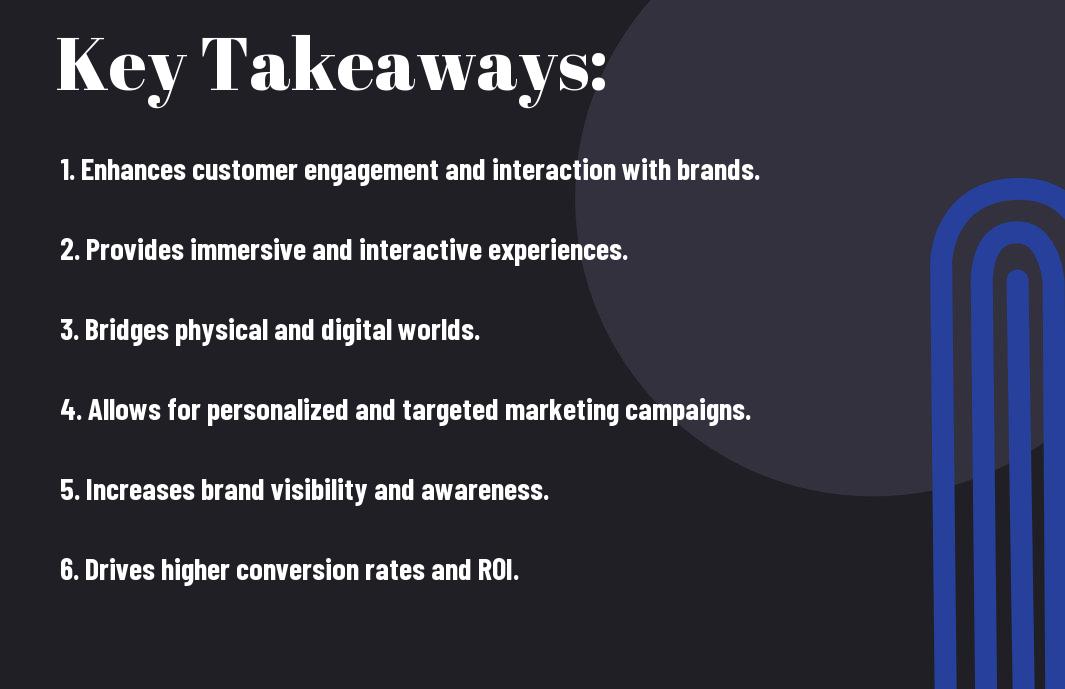It’s a fascinating time to be in the world of marketing as augmented reality (AR) is revolutionizing the way companies interact with their audiences. Gone are the days of traditional ads; now, with AR technology, you can create immersive, interactive experiences that capture the attention and engagement of your customers like never before. In this blog post, we’ll explore the impact of AR on modern digital marketing strategies and how you can leverage this powerful tool to stay ahead of the competition and enhance your brand’s presence in the digital landscape.
Key Takeaways:
- Enhanced customer engagement: Augmented Reality provides an interactive and immersive experience for customers, leading to increased engagement with the brand.
- Improved product visualization: AR allows customers to visualize products in real-world environments, helping them make more informed purchase decisions.
- Personalized marketing: By using AR technology, marketers can create customized and tailored experiences for their target audience, leading to more effective and personalized marketing campaigns.
The Evolution of Digital Marketing
From Traditional to Digital
While traditional marketing methods such as print ads, billboards, and TV commercials were once the go-to for reaching your audience, digital marketing has completely revolutionized the way businesses connect with consumers. With the advent of the internet and social media, you can now target specific demographics, track consumer behavior in real-time, and engage with your audience on a much more personal level.
The Rise of Immersive Technologies
Digital marketing has continued to evolve with the rise of immersive technologies such as augmented reality (AR) and virtual reality (VR). Digital technologies are transforming the way brands interact with their customers, providing more interactive and engaging experiences. You can now create virtual showrooms, allow customers to virtually try on products, and even place virtual items in their real-world environment.
Another exciting aspect of the rise of immersive technologies in digital marketing is the ability to collect valuable data on customer behavior and preferences. With AR, you can track how customers interact with virtual products, what they are most interested in, and use this data to tailor your marketing strategies to better meet their needs.

What is Augmented Reality?
One of the most innovative technologies in recent years, Augmented Reality (AR) blends digital elements into the real world, enhancing the user’s sensory experience. By overlaying virtual information onto a physical environment through devices like smartphones or smart glasses, AR provides interactive and engaging experiences not possible before.
Defining AR and its Capabilities
Reality is transformed as AR inserts computer-generated images, videos, or sounds into your surroundings, giving you a composite view. This technology has various capabilities, such as allowing you to visualize products in your home before purchasing, offering interactive guided tours, or enhancing training simulations with real-time feedback.
How AR Differs from Virtual Reality
Differs from Virtual Reality (VR) in that AR integrates digital elements into your existing environment, whereas VR creates a completely immersive experience in a computer-generated world, separate from the real one. To put it simply, AR adds to your reality, whereas VR replaces it entirely.

The Benefits of AR in Digital Marketing
Enhanced Customer Experience
Benefits of augmented reality (AR) in digital marketing are immense. Keep in mind that AR enhances customer experience by allowing you to provide immersive and interactive content, enabling potential customers to engage with your products or services in a whole new way. By incorporating AR technology into your digital marketing strategies, you can create memorable experiences that resonate with your target audience and set your brand apart from competitors.
Increased Engagement and Conversion Rates
Marketing with AR can significantly boost your engagement and conversion rates. The interactive and personalized nature of AR experiences captivates your audience and encourages them to spend more time interacting with your brand. This heightened engagement often translates into higher conversion rates as you offer a more compelling and memorable way for potential customers to experience your products or services.
The integration of AR features like virtual try-ons or product visualizations can lead to increased customer satisfaction and confidence in your offerings, ultimately driving conversions and sales for your business.
Cost-Effective and Measurable
On top of offering enhanced experiences and improved engagement, utilizing AR in your digital marketing efforts can be cost-effective and highly measurable. Keep in mind that implementing AR technology doesn’t always require a significant investment, especially with the availability of AR development tools and platforms. Additionally, AR campaigns can be easily tracked and analyzed, providing you with valuable insights into your audience’s interactions and behaviors.
By leveraging AR analytics, you can measure the effectiveness of your AR campaigns, identify areas for improvement, and make data-driven decisions to optimize your marketing strategies for better results.
AR Applications in Digital Marketing
Despite Augmented Reality in Marketing: A Digital Revolution, the true power of AR lies in its applications in digital marketing. Let’s explore how AR is transforming the digital marketing landscape and enhancing user engagement.
Virtual Product Demonstrations
Virtual product demonstrations are revolutionizing the way consumers experience products online. With AR, you can provide your customers with interactive and immersive demonstrations of your products in a virtual environment. This allows potential buyers to visualize the product in their own space, creating a more personalized and engaging shopping experience.
Interactive Storytelling and Branding
One of the key advantages of AR in digital marketing is the ability to create interactive storytelling experiences that captivate your audience. By integrating AR technology into your branding efforts, you can immerse users in your brand story in a way that traditional marketing methods cannot achieve. This not only enhances brand recall but also fosters a deeper connection with your target audience.
In-Store Experiences and Product Visualization
To enhance the in-store experience for your customers, AR can be used to provide virtual trials of products without the need for physical inventory. This not only saves on costs but also allows customers to try before they buy, leading to higher customer satisfaction and lower return rates.
Product visualization through AR enables customers to interact with products in a whole new way. By superimposing virtual elements onto the real world, customers can gain a better understanding of the product’s features and benefits, making informed purchasing decisions.
Challenges and Limitations of AR Adoption
Technical and Infrastructure Barriers
Alluring as augmented reality (AR) may seem, its implementation comes with its set of challenges. An array of technical and infrastructure barriers may hinder the seamless integration of AR technology. Issues such as compatibility across different devices, the need for high-speed internet connections, and the requirement for advanced hardware can pose obstacles to widespread adoption.
Cost and Accessibility Concerns
Challenges related to the cost of developing AR content and the accessibility of AR-compatible devices can limit the reach of AR marketing campaigns. The initial investment in creating AR experiences, along with the necessity for users to own compatible devices, can create barriers for both businesses and consumers.
Limitations in ensuring a seamless user experience can also impact the effectiveness of AR in digital marketing strategies. The need for intuitive interfaces, quick loading times, and real-time interaction in AR applications can be challenging to achieve, potentially leading to user frustration and disengagement.
Plus, overlooking these challenges and limitations can result in wasted resources and missed opportunities in leveraging the full potential of AR technology in your digital marketing efforts.
Industry Trends and Future Directions
Growing Demand for AR Experiences
To keep up with the ever-changing digital landscape, companies are increasingly turning to augmented reality (AR) to enhance their marketing strategies. Consumers today are seeking more interactive and engaging experiences with brands, and AR provides a unique way to captivate their attention. By offering immersive experiences that blend the virtual world with the real world, businesses can create lasting impressions and drive customer engagement like never before.
Advancements in AR Technology and Tools
To leverage the full potential of AR in your marketing campaigns, you need to stay abreast of the latest technological advancements and tools in the AR space. From improved object recognition and spatial mapping to more realistic simulations and seamless integrations, the possibilities with AR are expanding rapidly. With the right tools and technologies at your disposal, you can deliver high-quality and engaging AR experiences that resonate with your target audience.
A key aspect of the advancements in AR technology is the focus on user experience and accessibility. Developers are working tirelessly to make AR more intuitive and user-friendly so that brands can create seamless and enjoyable experiences for their customers.
Integration with Other Emerging Technologies
An exciting trend in AR is its integration with other emerging technologies such as artificial intelligence (AI) and Internet of Things (IoT). By combining these technologies, businesses can deliver hyper-personalized and context-aware experiences to their audience. Imagine a world where your AR marketing campaign not only responds to the user’s environment but also anticipates their needs and preferences in real-time.
Emerging integrations like these have the potential to revolutionize the way brands interact with consumers, creating deeply engaging and memorable experiences that drive customer loyalty and long-term relationships.
To wrap up
So, as you’ve learned, augmented reality is a powerful tool that can revolutionize digital marketing strategies. By incorporating AR into your campaigns, you can create interactive and engaging experiences for your audience, leading to increased brand awareness, customer engagement, and ultimately, sales. Remember to stay ahead of the curve and embrace this innovative technology to stand out in today’s competitive digital landscape.